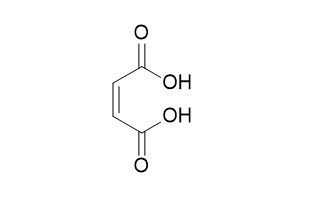Maleic acid
Maleic acid and succinic acid are the powerful stimulants of gastric acid output in fermented glucose and alcoholic beverages produced by fermentation.Maleic acid could used for calcium sulfate scale inhibition in high temperature application.
Inquire / Order:
manager@chemfaces.com
Technical Inquiries:
service@chemfaces.com
Tel:
+86-27-84237783
Fax:
+86-27-84254680
Address:
1 Building, No. 83, CheCheng Rd., Wuhan Economic and Technological Development Zone, Wuhan, Hubei 430056, PRC
Providing storage is as stated on the product vial and the vial is kept tightly sealed, the product can be stored for up to
24 months(2-8C).
Wherever possible, you should prepare and use solutions on the same day. However, if you need to make up stock solutions in advance, we recommend that you store the solution as aliquots in tightly sealed vials at -20C. Generally, these will be useable for up to two weeks. Before use, and prior to opening the vial we recommend that you allow your product to equilibrate to room temperature for at least 1 hour.
Need more advice on solubility, usage and handling? Please email to: service@chemfaces.com
The packaging of the product may have turned upside down during transportation, resulting in the natural compounds adhering to the neck or cap of the vial. take the vial out of its packaging and gently shake to let the compounds fall to the bottom of the vial. for liquid products, centrifuge at 200-500 RPM to gather the liquid at the bottom of the vial. try to avoid loss or contamination during handling.
Mol Pharm.2018, 15(8):3285-3296
J.of Traditional&Complementary Med.2022, 10.1016:j.jtcme.
Journal of Food Hygiene and Safety2019, 34(5):413-420
Antioxidants (Basel).2024, 13(3):340.
Int J Mol Sci.2024, 25(5):2799.
PLoS One.2018, 13(3):e0193386
Plants (Basel).2021, 10(6):1119.
Integr Med Res.2024, 13(1):101025.
Sci Rep.2018, 8:15059
Acta Biochim Pol.2015, 62(2):253-8
Related and Featured Products
Applied Surface ence, 2007, 254(2):616-620.
Aluminum pigment encapsulated by in situ copolymerization of styrene and maleic acid.[Reference:
WebLink]
METHODS AND RESULTS:
To improve its anticorrosion property, aluminum pigment was encapsulated by in situ copolymerization of styrene (St) and Maleic acid (MA). It was found that the conversion of monomers (C), the percentage of grafting (PG) and the grafting efficiency (GE) could attain 92%, 12%, 25%, respectively, when m(BPO)/ m(St + MA) = 10% and m(St + MA)/ m(Al) = 10%. The optimum condition for protection factor was studied according to an orthogonal testing. When m(St + MA)/ m(Al) was 20%, the encapsulated aluminum pigment simultaneously showed good anticorrosion property and luster.
CONCLUSIONS:
FTIR, SEM and particle size analysis indicated that aluminum pigment had been successfully encapsulated with styrene–Maleic acid copolymer by in situ copolymerization, which remarkably improved its anticorrosion property and the chelate complex formed between SMA and Al(III) was possibly the actual corrosion inhibitor.
Journal of Petroleum ence & Engineering, 2010, 75(1-2):189-195.
Maleic acid based scale inhibitors for calcium sulfate scale inhibition in high temperature application.[Reference:
WebLink]
In anhydrite rich reservoir rock, calcium sulfate is one of the dominant scale components which unlike carbonate scale are not easily removable by acid or dissolver treatment.
METHODS AND RESULTS:
To inhibit calcium sulfate scale formation in high temperature producing brine water systems, Maleic acid–acrylic acid and Maleic acid–acrylamide copolymers of appropriate molecular weight were synthesized and characterized and inhibition efficiency of the copolymers was tested at static and dynamic conditions. Their iron dispersing ability measured through UV spectroscopy is found to be excellent and their biocidal activity investigated through agar culture and serial dilution technique is almost insignificant.
CONCLUSIONS:
XRD and SEM analyses proved the morphological changes of the calcium sulphate scale due to strong inhibition action.
J Clin Invest. 1999 Mar 1; 103(5): 707–713.
Maleic acid and succinic acid in fermented alcoholic beverages are the stimulants of gastric acid secretion.[Pubmed:
10074488]
Alcoholic beverages produced by fermentation (e.g., beer and wine) are powerful stimulants of gastric acid output and gastrin release in humans. The aim of this study was to separate and specify the gastric acid stimulatory ingredients in alcoholic beverages produced by fermentation.
METHODS AND RESULTS:
Yeast-fermented glucose was used as a simple model of fermented alcoholic beverages; it was stepwise separated by different methods of liquid chromatography, and each separated solution was tested in human volunteers for its stimulatory action on gastric acid output and gastrin release. Five substances were detected by high-performance liquid chromatography and were analyzed by mass spectrometry and 1H-13C nuclear magnetic resonance spectroscopy. At the end of the separation process of the five identified substances, only the two dicarboxylic acids, Maleic acid and succinic acid, had a significant (P < 0.05) stimulatory action on gastric acid output (76% and 70% of fermented glucose, respectively), but not on gastrin release. When given together, they increased gastric acid output by 100% of fermented glucose and by 95% of maximal acid output.
CONCLUSIONS:
We therefore conclude that Maleic acid and succinic acid are the powerful stimulants of gastric acid output in fermented glucose and alcoholic beverages produced by fermentation, and that gastrin is not their mediator of action.



